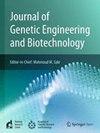Reverse vaccinology and immunoinformatics approaches for multi-epitope vaccine design against Klebsiella pneumoniae reveal a novel vaccine target protein
IF 2.8
Q3 Biochemistry, Genetics and Molecular Biology
Journal of Genetic Engineering and Biotechnology
Pub Date : 2025-05-23
DOI:10.1016/j.jgeb.2025.100510
引用次数: 0
Abstract
Klebsiella pneumoniae (K. pneumoniae), a Gram-negative pathogen, is a leading cause of hospital-acquired infections in Sudan and worldwide. The emergence of multidrug-resistant (MDR) strains has severely limited treatment options, underscoring the urgent need for an effective vaccine. In this study, we employed reverse vaccinology and immunoinformatics to design a novel multi-epitope vaccine targeting the hypervirulent NUBRI-K strain. Two conserved, non-host homologous iron acquisition proteins, IucA/IucC and FyuA, were prioritized as targets. The vaccine construct integrates six B-cell, six cytotoxic T lymphocyte (CTL), and six helper T lymphocyte (HTL) epitopes, linked by optimized spacers and fused to a β-defensin adjuvant. Computational analyses confirmed strong antigenicity (1.0429), non-allergenicity, and favorable solubility (0.477). Molecular docking revealed high-affinity binding to Toll-like receptor 4 (TLR4) (−278.22 kcal/mol), stabilized by eight hydrogen bonds and two salt bridges. Structural validation showed that 91 % of residues were located in favored regions of the Ramachandran plot. Additionally, CABSflex 2.0 dynamics analysis confirmed stable vaccine–TLR4 interactions, with minimal residue-level fluctuations (RMSF <1.5 Å), indicating conformational stability of the complex. In silico immune simulations predicted potent humoral and cellular responses, including elevated IgG/IgM titers, T-cell proliferation, and IFN-γ secretion. The construct was further optimized for mammalian expression, achieving an ideal GC content (48.27 %) and a codon adaptation index (CAI) of 1.0, facilitating efficient in silico cloning into the pcDNA3 vector. By targeting conserved iron acquisition systems, this vaccine candidate presents a promising strategy to combat antibiotic-resistant K. pneumoniae while minimizing selective pressure. Future in vitro and in vivo studies are warranted to validate its immunogenicity and protective efficacy.

针对肺炎克雷伯菌多表位疫苗设计的反向疫苗学和免疫信息学方法揭示了一种新的疫苗靶蛋白
肺炎克雷伯菌(肺炎克雷伯菌)是一种革兰氏阴性病原体,是苏丹和全世界医院获得性感染的主要原因。耐多药(MDR)菌株的出现严重限制了治疗选择,突出表明迫切需要一种有效的疫苗。在这项研究中,我们利用反向疫苗学和免疫信息学设计了一种针对高毒力NUBRI-K菌株的新型多表位疫苗。两个保守的非宿主同源铁获取蛋白IucA/IucC和FyuA被优先作为靶点。该疫苗结构整合了6个b细胞、6个细胞毒性T淋巴细胞(CTL)和6个辅助T淋巴细胞(HTL)表位,通过优化的间隔物连接并融合到β-防御素佐剂上。计算分析证实了较强的抗原性(1.0429)、非过敏性和良好的溶解度(0.477)。分子对接显示toll样受体4 (TLR4)具有高亲和力(−278.22 kcal/mol),通过8个氢键和2个盐桥稳定。结构验证表明,91%的残基位于Ramachandran图的有利区域。此外,CABSflex 2.0动力学分析证实了稳定的疫苗- tlr4相互作用,具有最小的残留水平波动(RMSF <1.5 Å),表明该复合物的构象稳定性。计算机免疫模拟预测了强有力的体液和细胞反应,包括IgG/IgM滴度升高、t细胞增殖和IFN-γ分泌。进一步优化了该构建体在哺乳动物中的表达,获得了理想的GC含量(48.27%)和密码子适应指数(CAI)为1.0,便于高效地在pcDNA3载体上进行硅克隆。通过靶向保守的铁获取系统,这种候选疫苗提出了一种有希望的策略来对抗耐抗生素肺炎克雷伯菌,同时最小化选择压力。进一步的体外和体内研究将进一步证实其免疫原性和保护作用。
本文章由计算机程序翻译,如有差异,请以英文原文为准。
求助全文
约1分钟内获得全文
求助全文
来源期刊

Journal of Genetic Engineering and Biotechnology
Biochemistry, Genetics and Molecular Biology-Biotechnology
CiteScore
5.70
自引率
5.70%
发文量
159
审稿时长
16 weeks
期刊介绍:
Journal of genetic engineering and biotechnology is devoted to rapid publication of full-length research papers that leads to significant contribution in advancing knowledge in genetic engineering and biotechnology and provide novel perspectives in this research area. JGEB includes all major themes related to genetic engineering and recombinant DNA. The area of interest of JGEB includes but not restricted to: •Plant genetics •Animal genetics •Bacterial enzymes •Agricultural Biotechnology, •Biochemistry, •Biophysics, •Bioinformatics, •Environmental Biotechnology, •Industrial Biotechnology, •Microbial biotechnology, •Medical Biotechnology, •Bioenergy, Biosafety, •Biosecurity, •Bioethics, •GMOS, •Genomic, •Proteomic JGEB accepts
 求助内容:
求助内容: 应助结果提醒方式:
应助结果提醒方式:


